Table of Contents
Business is changing fast. To succeed over time, companies must keep watch on competitors. New players enter markets all the time. Traditional competitor research can’t keep up.
You need tools with current data on what rivals are doing. Their strategies, messaging, and focus – having these real-time insights is important.
We’ll look at some top competitive analysis tools. They give up-to-date info on industry shifts and competitor moves. This helps companies make smart calls to compete well as things change around them.
Staying informed is key in unpredictable times.
🏆 How We Picked the Best Competitor Analysis Tools
Why Do You Need a Competitor Analysis Tool?
Wondering what all the hype around competitor analysis tools is about? We’ve got the scoop on why they should be part of your success toolkit.
Let’s face it – we all love being lazy. But as the old saying goes, knowledge is power in business. Frequently tracking what your competition is up to using the right keyword-tracking tools is anything but lazy – it’s strategic. Staying on top of trends helps you create highly targeted SEO efforts and email marketing services.
Putting yourself in your rivals’ shoes with competitive analysis tools reveals improvements you may not see otherwise. Competitor research uncovers blindspots before the competition does. It’s like getting an insider’s peek under their hood!
We’re not saying spy, but do keep casually peeking over that fence now and again. You can elevate your game with the right mix of respect and a little friendly espionage. And wouldn’t you rather be at the top of your game than scrambling to catch up later?
So invest in yourself, future-proofing your success. Competitor analysis doesn’t need to be hard, and the right automated competitor analysis software makes it efficient. Consider it like a spot of market research – just a little more focused on those trying to beat you. Knowledge is power, guys. Now go empower yourself!
While analyzing your competitors’ social media strategies, it’s crucial not to overlook the technologies that enable you to streamline such efforts. Incorporating reliable demo automation options into your toolbox can be a game-changer, particularly for businesses looking to efficiently showcase their products or services to potential clients at scale.
Competitor Analysis Tools for Social Media
1. Sprout Social
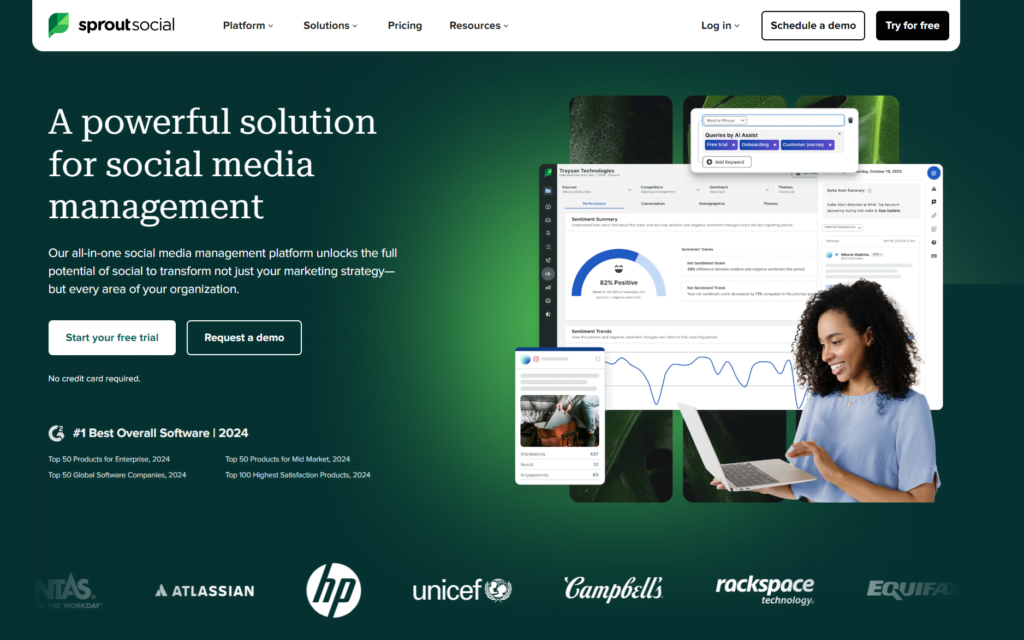
Connecting with customers isn’t just about products – it’s relationships. Sprout lets you engage across networks directly from its centralized dashboard. Save time by avoiding separate tools.
Smart algorithms uncover influencers and brand advocates, boosting word-of-mouth with less effort. AI insights reveal top strategies
Sprout supports all company sizes, perfect for optimizing social efforts without losing sanity. If spreadsheets still manage your efforts, it’s time to upgrade with Sprout’s comprehensive system.
Key Features:
- This centralized social media hub stores all TikTok, Facebook, Instagram, LinkedIn, and WhatsApp messages in one simple stream. Forever done with network hopping – all customer care is conveniently located here.
- Keyword alerts and competitor research tools stand sentry over your company name 24/7. No sneaky social slight will slip past watchful virtual eyes again!
- By keeping comprehensive histories of all past customer interactions visible, teams can deliver seamlessly stellar service time after time. Replies stay fully informed with important context a breeze away.
Limitations:
- The basic plan limits you to one user and up to 3 social profiles. If your team is larger or you manage multiple brands, it may not scale up well without paying extra.
- You’re tied to their interface – there’s no easy way to export your data for analysis in other tools. For number-crunching folks, this lack of flexibility could be limiting.
- It doesn’t play nice with other major CRM or marketing platforms out of the box. Getting seamless integration would require building custom connectors yourself.
Pricing: $249/month
2. 🏅 Our Pick – Talkwalker Quick Search
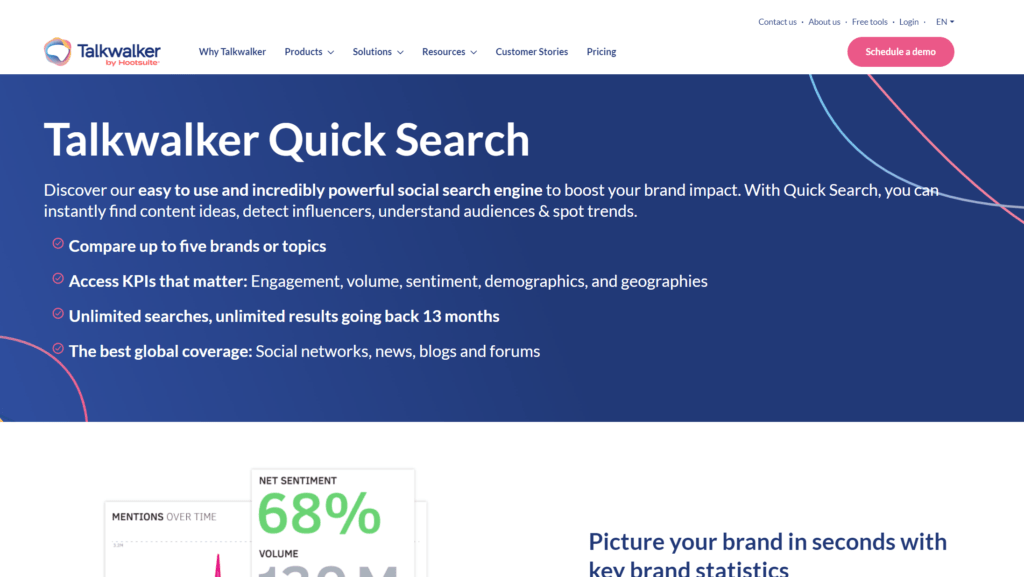
Quick Search saves search time. It queries titles, content, and an index as you type, displaying matches that you can follow.
No more menu digging – start typing to navigate. Wildcards like “tuber*” cover alternatives. Hover over colored boxes for quick result sources.
Imperfect queries still work via flexible suggestions. Next time you’re looking for a hard-to-find section or snippet, try Quick Search for fast, fuzzy cross-document searching. Easy navigation arrives.
Key Features:
- Their blazing-fast search taps into massive data lakes, locating what you need in seconds. Gone are the days of waiting anxiously – results come quickly as a flash!
- Precisely hone in on what matters most for your business using our wide range of filter options. Slice and dice searches to your heart’s content.
- Make Quick Search your one-stop shop for all information trials and tribulations. Leverage our treasure trove of business guides, articles and community wisdom like the quick-witted pro you are.
Limitations:
- It only scans your website’s pages – you don’t get insights into how customers search and click beyond your domain.
- There’s no integration with analytics tools, so linking clicks and behavior to specific keywords takes extra work.
- The free version caps results at 250 keywords a month. For large sites with thousands searched, this could leave some gaps in your keyword data.
Pricing: $19.97 one-time payment
Why is Quick Search our Top Pick?
We picked Quick Search as the best tool because it finds what you need incredibly fast. As you type, it shows matches across titles and pages. No more menu digging – typing takes you where you want to go. It even helps with unclear searches through suggestions.
Quick Search taps huge amounts of data to return results instantly. You can filter searches exactly as needed too. It has lots of handy information so it’s a one-stop shop. While it just searches your own site, Quick Search saves lots of time with its easy and rapid searching.
3. Phlanx
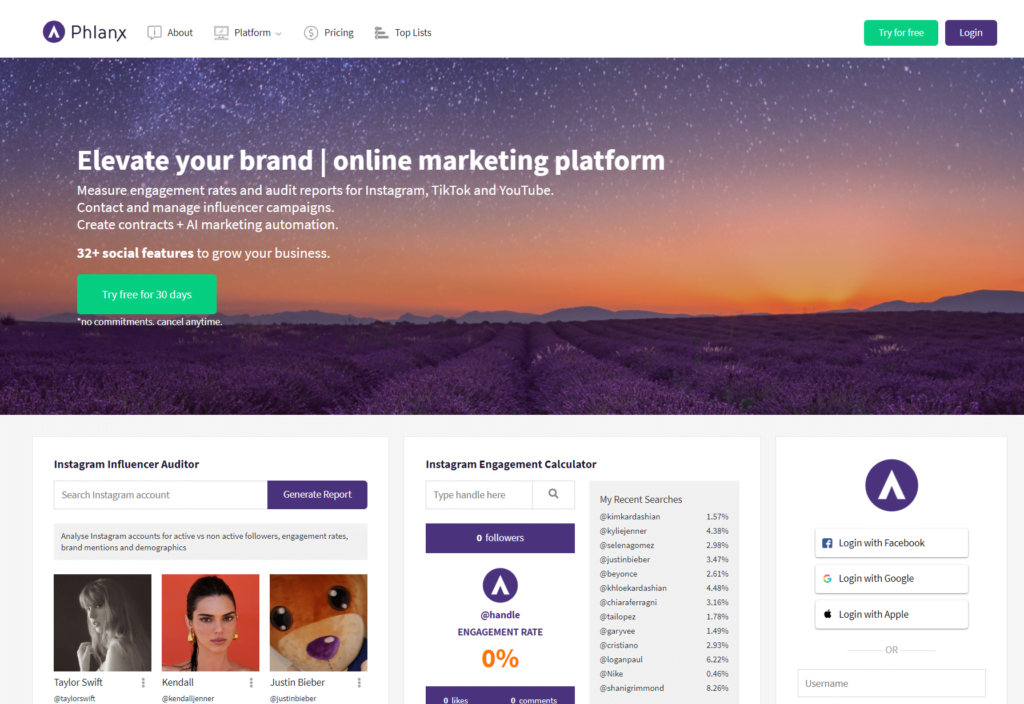
Phlanx aims to simplify social marketing partnerships.
Its all-in-one platform offers engagement analytics, SEO competitor analysis tools and calculators across networks. Measure performance from one login.
Effortlessly connect brands and influencers through Phlanx’s directory. Directly contact and collaborate on partners. Automated contracts and workflows efficiently scale campaigns while ensuring compliance.
Say goodbye to disjointed competitor analysis tools and tedious manual tasks. Phlanx integrates all social efforts into a single powerful command center.
Key Features:
- Phlanx keeps tabs on social media 24/7 to catch any mentions of your brand. Eagle-eyed monitoring spots trends and issues swiftly.
- Locate exactly what you’re looking for with powerful faceted search filters. Drill down on keywords, networks, sentiment and more.
- Phlanx sniffs out the most effective influencers and creators in any industry. Leverage their discoveries to boost your reach.
Limitations:
- The configuration takes time – it’s not a simple plug-and-play solution. You need the skills to properly integrate and customize it for your site.
- Uptime isn’t guaranteed to be 100%. Bot blocks aren’t foolproof so some automated traffic may still sneak through on rare occasions.
- It can’t stop certain types of advanced bot attacks that are constantly evolving tactics. For cutting-edge protection, you’d need a managed security provider too.
Pricing: $49-$100
4. Social Blade
Social Blade deeply analyzes top social platforms like YouTube and Instagram. Their all-in-one dashboard aggregates detailed metrics like views, likes and comments from multiple days.
Effortlessly monitor more than just follower counts. predictive algorithms also auto-generate trends for deeper insights.
Make Social Blade your new competitor analysis tool for robust data analytics beyond basic stats. Leave no metric untouched with their data-packed platform.
Key Features:
- See subscriber and view projections to anticipate your growth trajectory. Make informed plans thanks to crystal ball estimates into weeks and months ahead!
- Visualize your daily and monthly performance via colorful charts. Social Blade makes stats simple so you always know exactly what’s clicking.
- Inspect support from colleagues via the in-depth featured channels section. Benchmark networking against others to maximize promotion potential across all rosters.
Limitations:
- Data shown is just estimates – there’s no guarantee of complete accuracy since they don’t have direct access to every platform’s internal stats.
- Only covers big YouTube and Twitch stars – smaller influencers don’t hit their reporting thresholds. So you miss insights on grassroots competitors.
- Metrics are limited to subscribers/followers over time – they don’t provide deeper analysis of engagement patterns, content themes, demographics and more. For strategizing, those extra dimensions could be valuable.
Pricing:
- Bronze: $3.99/month
- Silver: $9.99/month
- Gold: $39.99/month
Competitor Analysis Tools for SEO
1.🏅Our Pick – Semrush
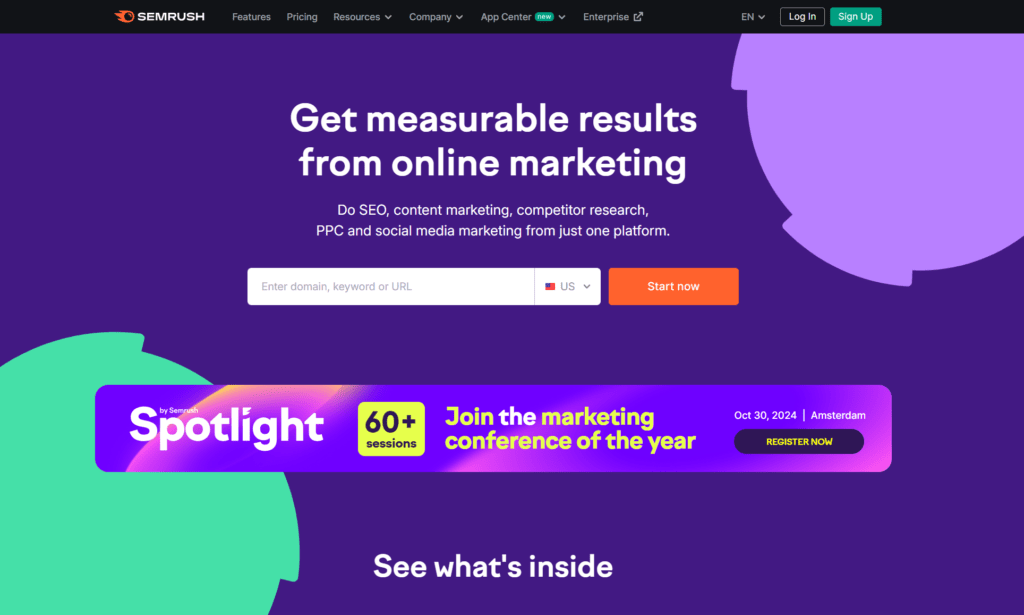
Their all-in-one toolkit eases Multi-channel efforts across PPC, content and social media. Page audits and keyword plus competitor insights illuminate an optimized path.
Heavy decision-loads lifted, just let Semrush’s optimizers work magic. Traffic will soon school rivals as strategies dunk the house.
Key Features:
- Track exactly where you rank for target keywords on search engines like Google with Semrush’s position tracking tool. Know how well your SEO is really working.
- Audit the on-page elements that search engines love to see with their in-depth technical SEO report. Semrush helps identify issues to boost your rankings.
- Generate optimized blog post and article ideas tailored to target keywords using Semrush’s content templates and topic research. Kickstart fresh material to attract searchers.
Limitations:
- Tracking is limited to 25 keywords/domains per month on the basic plan. Power users need a paid upgrade for unlimited searches.
- There’s no built-in publishing or collaboration features like you get from dedicated social media management tools.
- The interface can be complex, with a lot of data thrown at you. It requires taking time to learn how to effectively analyze the insights.
Pricing:
- Pro: $129/month
- Guru: $249/month
- Business: $499/month
Why is Semrush our Top Pick?
We chose Semrush as the best tool. Its all-in-one toolkit makes PPC, SEO, and social media easy. It shows what pages need work and competitor insights.
Semrush also finds the best keywords and content ideas. You can see exactly how results are looking online. It lifts heavy decision loads so traffic keeps growing. The basic plan still tracks well monthly. Semrush saves tons of time even if publishing elsewhere. While its interface has data, learning analysis provides top benefits. Overall, Semrush streamlines marketing success.
2. Ahrefs
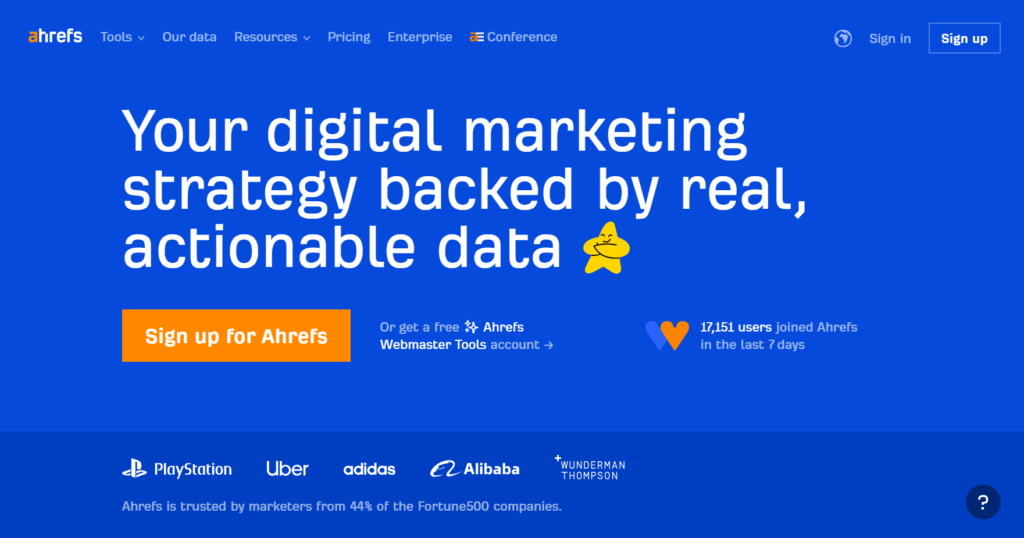
Ahrefs is a leading SEO competitor analysis tool that helps marketers optimize strategies. It scours the web for valuable metrics like backlinks, keyword opportunities and competitor insights.
Users can discover new angles from Ahrefs’ extensive databases. The tool audits sites to spot any issues hurting visibility too.
Key Features:
- Find websites that may want to link to yours through Ahrefs’ extensive backlink database and scraper. Grow your authority through strategic outreach.
- Discover optimal keywords to target using Ahrefs’ competitor research tools like keyword gaps, search volume, and difficulty. Optimize your content for the terms most likely to win.
- Continuously monitor your rankings 24/7 for chosen keywords across search engines big and small using Ahrefs’ tracking feature. Jump on rank increases or remedy slips quickly.
Limitations:
- The basic plan only allows 7,500 monthly impressions. Bigger brands need an upgraded plan for unlimited data.
- It focuses solely on SEO insights like backlinks, keywords, and technical pages. You’ll need other competitor analysis tools for social reporting.
- The interface can be very technical, optimized for seasoned analysts. New users may find the learning curve steep.
Pricing:
- Lite: $99/month
- Standard: $199/month
- Advanced: $399/month
3. MozBar

MozBar is a handy Chrome extension that equips SEOs with insights as they browse. It seamlessly surfaces key metrics like authority, backlinks and link types directly in browser.
Custom profiles focus findings while highlights and audits spot optimization chances. When paired with Moz Pro, unlimited reports offer benchmarking at your fingertips wherever you roam.
Key Features:
- Run custom searches across engines, regions, and countries to better understand search behavior worldwide. MozBar broadens your keyword research horizons.
- Check vital metrics like links, domain ratings, and traffic for any page displayed in search results. It empowers you to quickly evaluate SERP competitors.
- Leverage the on-page highlighter to identify and don’t elements on your own pages. This helps fine-tune content for improved communication with search engines.
Limitations:
- It’s a browser extension rather than a standalone software, so you need to use Chromium-based browsers like Chrome or Brave to access its features.
- Functionality is limited to quick checks rather than deep analysis – there’s no comprehensive dashboard as other SAAS tools provide.
- Being a free product, it has fewer features compared to Moz’s premium offerings. More advanced capabilities require a Pro or Enterprise subscription.
Pricing:
- Standard: $99/month
- Medium: $179/month
- Large: $299/month
- Premium: $599/month
4. SE Ranking
SE Ranking is a robust cloud platform housing potent SEO competitor analysis tools. It automates tedious tasks like site audits, competitor analyses and ranking tracking.
Regular updates keep key metrics and insights accessible at a glance. Users can plug findings straight into plans without sweat.
Key Features:
- Discover goldmine keywords through comprehensive research on search volume, competition analysis tool, and trends. SE Ranking tools light the way to high opportunity terms.
- Audit your backlinks and find prospects for outreach using network mapping and domain reports. Strengthen your web of authority through strategic link-building.
- Continually monitor target keyword positions across major search engines with centralized rank tracking. Stay ahead of the algorithm curve by addressing any slips or surges fast.
Limitations:
- The free version only allows tracking of 10 keywords, which could quickly prove limiting for businesses monitoring many terms.
- Functionality is limited to rankings and index status compared to more robust tools offering additional insights like backlinks and competition.
- The interface is quite basic, lacking advanced features for customized reporting or collaboration with teams found in other Ranking tools.
Pricing:
- Pro: $87.20/month
- Business: $191.20/month
Competitor Analysis Tools for Content
1. Buzzsumo
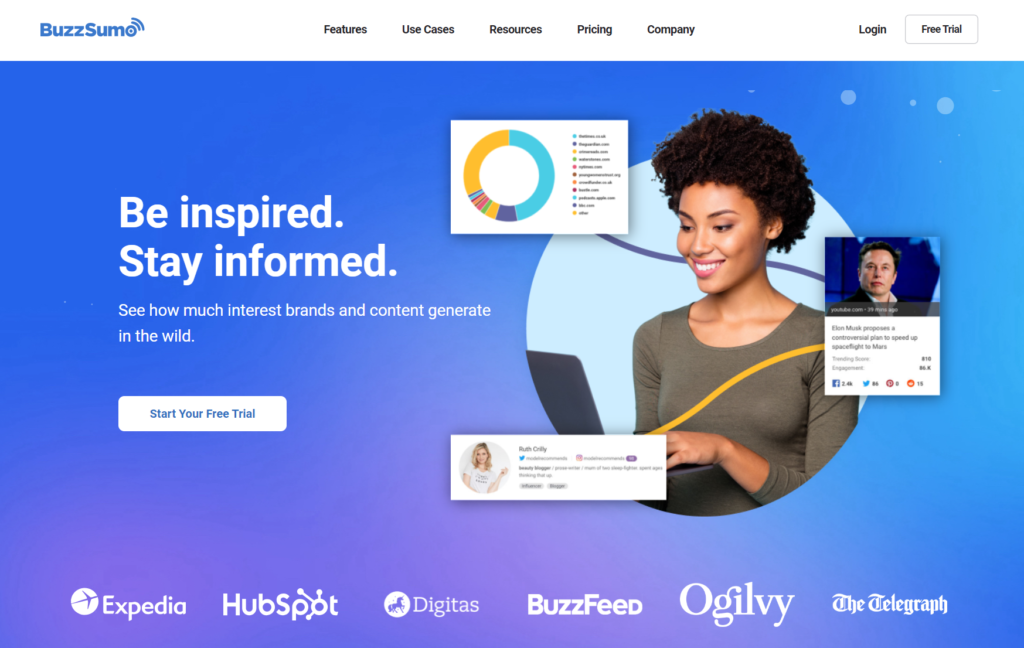
Buzzsumo efficiently discovers influencers and engaging content. Simply search keywords to uncover social victors with strong reach.
The tool also identifies notable figures within fields. Users gain insightful prospects for outreach through trend tracking and backlink hunting made effortless.
Key Features:
- Buzzsumo offers unmatched content and social engagement data from across the web. It tracks performance metrics for content on blogs, news sites and social media globally.
- The tool provides data in many different languages, giving insights into what article types resonate with target audiences worldwide.
- It offers features that allow entire teams, from writers to executives, to access insights from a single unified data source. Different interface options cater to various user needs.
Limitations:
- It focuses only on content performance data like shares and engagement without broader rankings or keyword insights.
- The free version limits searches and some data points are only available on paid plans starting at $99 per month.
- Advanced metrics like sentiment analysis or customized reporting require more expensive Enterprise plans, making it cost-prohibitive for some smaller companies or individual users.
Pricing:
- Pro: $79/month
- Plus: $139/month
- Large: $239/month
2. 🏅Our Pick – Similarweb
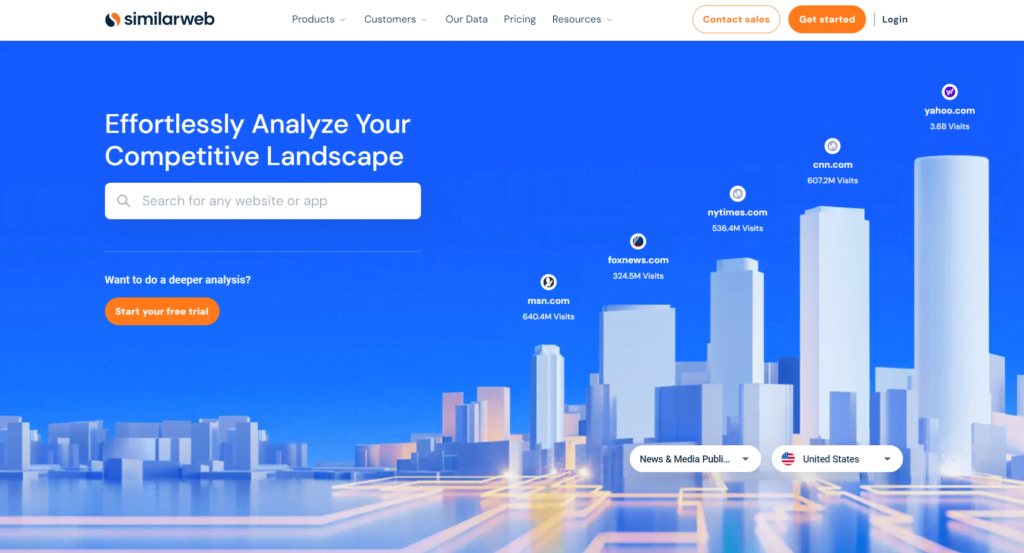
Similarweb efficiently reveals competitor insights. Simply enter a URL to uncover top referral sources, social promoters and high-value keywords.
This handy traffic recon tool removes guessing from growth. Emerging avenues surface seamlessly, empowering users to refine strategies before rivals react.
Key Features:
- It tracks search queries over time so you see rising and falling trends. This helps spot up-and-coming keywords to target.
- The tool provides fresh data to discover new searches. You’ll always have your finger on the pulse of changing search behaviors.
- Real visitor insights mean taking advantage of traffic numbers. Similarweb shows which sites and pages people actually use, not just searchers.
Limitations:
- It focuses exclusively on digital marketing and web analytics without integrated SEO, social or competitive analysis tools.
- Some detailed metrics require paid plans, and the largest sites hit data limits on lower tiers.
- The interface can feel complex, making it harder for casual users to extract insights without training.
Pricing: Free
Why is Similarweb our Top Pick?
We chose Similarweb as the best tool. Entering a URL quickly reveals a competitor’s traffic sources, keywords, and promoters. This removes guessing from growth strategies. Emerging chances surface, allowing Strategy changes before rivals. Keyword trends spot new targets. Fresh data finds developing queries. Real visitor insights use true traffic, not just searches. It focuses on digital insights but accelerates optimization. More data requires higher plans, though value stays at all levels. With use, the interface provides benefits, and simplicity remains key.
3. Feedly
Feedly streamlines news discovery. The aggregator customizes topic clusters from extensive sources for convenient access anywhere.
Searching stress dissolves as it effortlessly organizes online publications. Free cloud sync keeps streams snappy across devices too. Users collaborate seamlessly on collections through invites.
Key Features:
- It allows you to follow 1,000 RSS feeds, keeping you up to date on topics from around the web. Never miss the latest news.
- The notes and highlights feature means making connections between articles. Tag important points to revisit later.
- Power Search scans your subscriptions and beyond to quickly locate stuff. Find that perfect article without endlessly scrolling your feeds.
Limitations:
- It focuses only on feed aggregation and article discovery without deeper analytics capabilities.
- The free version has basic features, but advanced sorting, collaboration or archiving require paid upgrades.
- Customizing streams takes time and effort – it works best for general content discovery versus highly tailored workflows.
Pricing: $8/month
Competitor Analysis Tools for Emails and Paid Ads
1. 🏅Our Pick – MailCharts
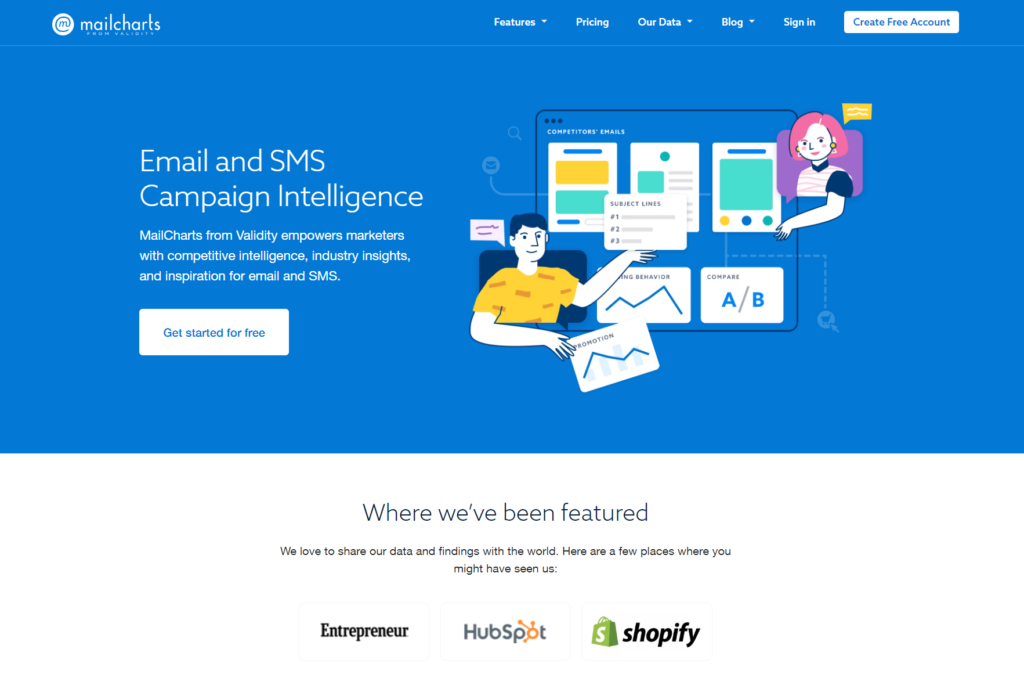
MailCharts equips strategies seamlessly through top brand insight. Peek peer campaigns or customize sequences effortlessly within curated category boards.
No fishing needed – its data dynamism tracks trends for streamlined focus. Discover lucrative niches through carefully clipped viewboards and industry groups numbering over 80 representing commerce’s pulse.
Key Features:
- It provides real-time and past performance metrics so you can make smart email decisions. See what content hooks people in delivery and open rates.
- The platform lets you browse, comment on, and share actual campaign emails from well-known and up-and-coming brands. Get inspiration from top examples.
- Messages are organized by category so you can easily find ideas tailored to your products. We’re talking triggered receipts, newsletters and more – all at your fingertips.
Limitations:
- It focuses only on email analytics without tools for building full campaigns or tracking additional channels.
- Their free plan limits time-series charting to the past 30 days, while paid plans start at $29/month for businesses.
- The pre-built templates aim for functionality over creativity, so marketers may prefer design-focused platforms for visually-impactful reports.
Pricing: $149/month
Why is MailCharts our Top Pick?
We chose MailCharts as best. It smoothly fills strategies with top brand insights. See similar campaigns or customize emails easily by category. No digging needed -tracking shows trends clearly.
Over 80 industry groups present useful ideas. It provides metrics to understand past and present results. See what messages engaged people. Copy real examples from known brands too. Finding newsletter and receipt templates is quick by topic. Only email analytics are shown, not full campaigns. But free and low-cost insights benefit marketers greatly.
2. Owletter
Owletter streamlines competitor email analysis. The tool automatically archives screenshots and annotations for seamless review.
No more manual monitoring – simply assign sites to effortlessly track pertinent messages. Amass insightful intel to imitate innovators or best also-rans.
Key Features:
- It makes testing newsletter designs a breeze. Easily swap text, images and layouts to see what performs best with your subscribers.
- The split testing lets you run A/B or multivariate tests to find winning combos. See measurable differences directly in your mail client.
- Personalization tools allow tailored messages at scale. You can customize content and calls to action for each reader segment.
Limitations:
- It focuses only on email newsletter creation and delivery without broader campaign or engagement tools.
- The free tier limits designs, email lists, and deliveries which may not meet larger publishers’ needs.
- Compared to full-featured platforms, it lacks advanced segmentation, personalization, or analytics capabilities expected by power users.
Pricing:
- Starter: $19/month
- Pro: $39/month
- Unlimited: $79/month
Conclusion
In conclusion, keeping up with competitor analysis tools is really important nowadays. Businesses are always changing quickly.
The tools talked about try to give current info on what rivals do and how markets change. They look at websites and ads. They put together a lot of competitor data in one place.
But not all tools are the same. Some work better than others for different companies.
It’s important to pick the right one that fits your business. Then you can make good choices. Knowing what competitors are up to helps adapt. And you can find ways to do better. Always watching competitors allows you to do well even as things change.







Add your first comment to this post